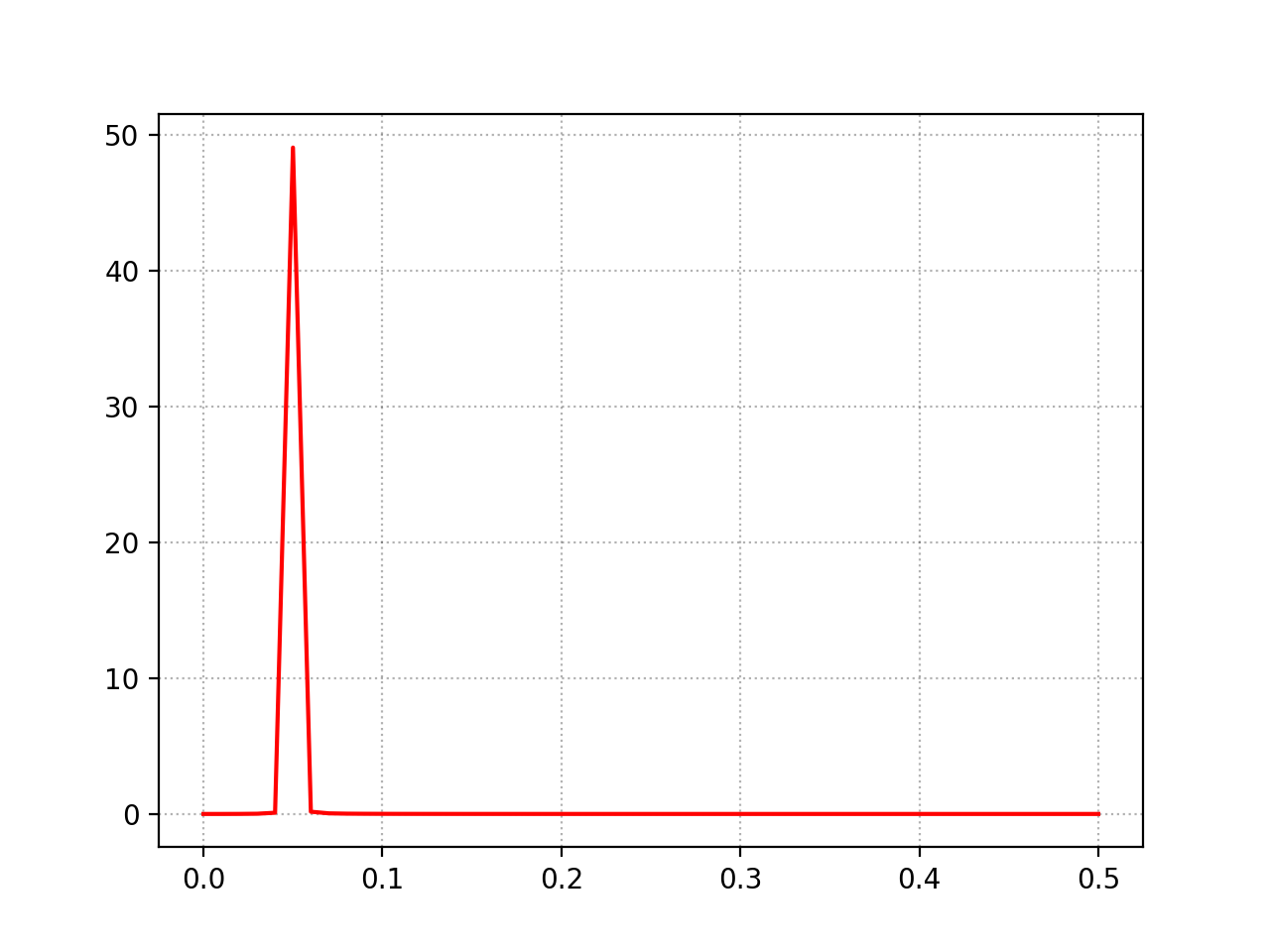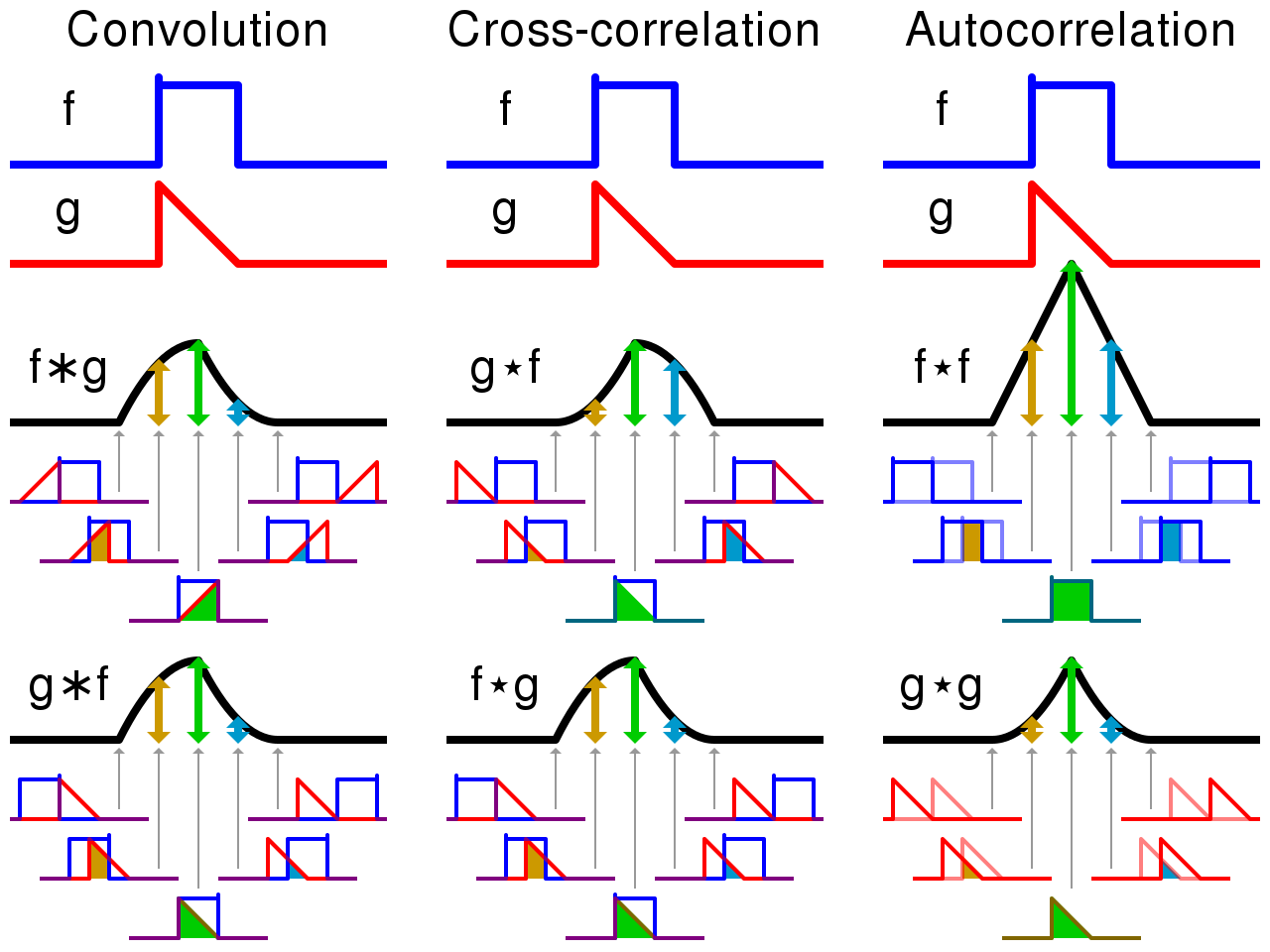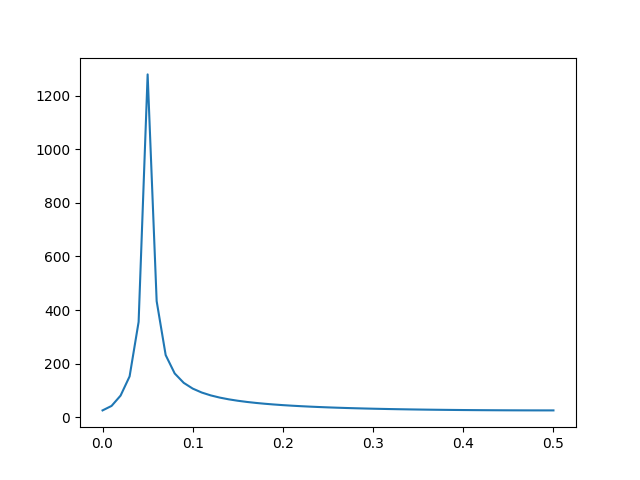Suppose one wanted to find the period of a given sinusoidal wave signal. From what I have read online, it appears that the two main approaches employ either fourier analysis or autocorrelation. I am trying to automate the process using python and my usage case is to apply this concept to similar signals that come from the time-series of positions (or speeds or accelerations) of simulated bodies orbiting a star.
For simple-examples-sake, consider x = sin(t) for 0 ≤ t ≤ 10 pi.
import numpy as np
from scipy import signal
import matplotlib.pyplot as plt
## sample data
t = np.linspace(0, 10 * np.pi, 100)
x = np.sin(t)
fig, ax = plt.subplots()
ax.plot(t, x, color='b', marker='o')
ax.grid(color='k', alpha=0.3, linestyle=':')
plt.show()
plt.close(fig)
Given a sine-wave of the form x = a sin(b(t+c)) + d, the period of the sine-wave is obtained as 2 * pi / b. Since b=1 (or by visual inspection), the period of our sine wave is 2 * pi. I can check the results obtained from other methods against this baseline.
Attempt 1: Autocorrelation
As I understand it (please correct me if I'm wrong), correlation can be used to see if one signal is a time-lagged copy of another signal (similar to how cosine and sine differ by a phase difference). So autocorrelation is testing a signal against itself to measure the times at which the time-lag repeats said signal. Using the example posted here:
result = np.correlate(x, x, mode='full')
Since x and t each consist of 100 elements and result consists of 199 elements, I am not sure why I should arbitrarily select the last 100 elements.
print("\n autocorrelation (shape={}):\n{}\n".format(result.shape, result))
autocorrelation (shape=(199,)):
[ 0.00000000e+00 -3.82130761e-16 -9.73648712e-02 -3.70014208e-01
-8.59889695e-01 -1.56185995e+00 -2.41986054e+00 -3.33109112e+00
-4.15799070e+00 -4.74662427e+00 -4.94918053e+00 -4.64762251e+00
-3.77524157e+00 -2.33298717e+00 -3.97976240e-01 1.87752669e+00
4.27722402e+00 6.54129270e+00 8.39434617e+00 9.57785701e+00
9.88331103e+00 9.18204933e+00 7.44791758e+00 4.76948221e+00
1.34963425e+00 -2.50822289e+00 -6.42666652e+00 -9.99116299e+00
-1.27937834e+01 -1.44791297e+01 -1.47873668e+01 -1.35893098e+01
-1.09091510e+01 -6.93157447e+00 -1.99159756e+00 3.45267493e+00
8.86228186e+00 1.36707567e+01 1.73433176e+01 1.94357232e+01
1.96463736e+01 1.78556800e+01 1.41478477e+01 8.81191526e+00
2.32100171e+00 -4.70897483e+00 -1.15775811e+01 -1.75696560e+01
-2.20296487e+01 -2.44327920e+01 -2.44454330e+01 -2.19677060e+01
-1.71533510e+01 -1.04037163e+01 -2.33560966e+00 6.27458308e+00
1.45655029e+01 2.16769872e+01 2.68391837e+01 2.94553896e+01
2.91697473e+01 2.59122266e+01 1.99154591e+01 1.17007613e+01
2.03381596e+00 -8.14633251e+00 -1.78184255e+01 -2.59814393e+01
-3.17580589e+01 -3.44884934e+01 -3.38046447e+01 -2.96763956e+01
-2.24244433e+01 -1.26974172e+01 -1.41464998e+00 1.03204331e+01
2.13281784e+01 3.04712823e+01 3.67721634e+01 3.95170295e+01
3.83356037e+01 3.32477037e+01 2.46710643e+01 1.33886439e+01
4.77778141e-01 -1.27924775e+01 -2.50860560e+01 -3.51343866e+01
-4.18671622e+01 -4.45258983e+01 -4.27482779e+01 -3.66140001e+01
-2.66465884e+01 -1.37700036e+01 7.76494745e-01 1.55574483e+01
2.90828312e+01 3.99582426e+01 4.70285203e+01 4.95000000e+01
4.70285203e+01 3.99582426e+01 2.90828312e+01 1.55574483e+01
7.76494745e-01 -1.37700036e+01 -2.66465884e+01 -3.66140001e+01
-4.27482779e+01 -4.45258983e+01 -4.18671622e+01 -3.51343866e+01
-2.50860560e+01 -1.27924775e+01 4.77778141e-01 1.33886439e+01
2.46710643e+01 3.32477037e+01 3.83356037e+01 3.95170295e+01
3.67721634e+01 3.04712823e+01 2.13281784e+01 1.03204331e+01
-1.41464998e+00 -1.26974172e+01 -2.24244433e+01 -2.96763956e+01
-3.38046447e+01 -3.44884934e+01 -3.17580589e+01 -2.59814393e+01
-1.78184255e+01 -8.14633251e+00 2.03381596e+00 1.17007613e+01
1.99154591e+01 2.59122266e+01 2.91697473e+01 2.94553896e+01
2.68391837e+01 2.16769872e+01 1.45655029e+01 6.27458308e+00
-2.33560966e+00 -1.04037163e+01 -1.71533510e+01 -2.19677060e+01
-2.44454330e+01 -2.44327920e+01 -2.20296487e+01 -1.75696560e+01
-1.15775811e+01 -4.70897483e+00 2.32100171e+00 8.81191526e+00
1.41478477e+01 1.78556800e+01 1.96463736e+01 1.94357232e+01
1.73433176e+01 1.36707567e+01 8.86228186e+00 3.45267493e+00
-1.99159756e+00 -6.93157447e+00 -1.09091510e+01 -1.35893098e+01
-1.47873668e+01 -1.44791297e+01 -1.27937834e+01 -9.99116299e+00
-6.42666652e+00 -2.50822289e+00 1.34963425e+00 4.76948221e+00
7.44791758e+00 9.18204933e+00 9.88331103e+00 9.57785701e+00
8.39434617e+00 6.54129270e+00 4.27722402e+00 1.87752669e+00
-3.97976240e-01 -2.33298717e+00 -3.77524157e+00 -4.64762251e+00
-4.94918053e+00 -4.74662427e+00 -4.15799070e+00 -3.33109112e+00
-2.41986054e+00 -1.56185995e+00 -8.59889695e-01 -3.70014208e-01
-9.73648712e-02 -3.82130761e-16 0.00000000e+00]
Attempt 2: Fourier
Since I am not sure where to go from the last attempt, I sought a new attempt. To my understanding, Fourier analysis basically shifts a signal from/to the time-domain (x(t) vs t) to/from the frequency domain (x(t) vs f=1/t); the signal in frequency-space should appear as a sinusoidal wave that dampens over time. The period is obtained from the most observed frequency since this is the location of the peak of the distribution of frequencies.
Since my values are all real-valued, applying the Fourier transform should mean my output values are all complex-valued. I wouldn't think this is a problem, except for the fact that scipy has methods for real-values. I do not fully understand the differences between all of the different scipy methods. That makes following the algorithm proposed in this posted solution hard for me to follow (ie, how/why is the threshold value picked?).
omega = np.fft.fft(x)
freq = np.fft.fftfreq(x.size, 1)
threshold = 0
idx = np.where(abs(omega)>threshold)[0][-1]
max_f = abs(freq[idx])
print(max_f)
This outputs 0.01, meaning the period is 1/0.01 = 100. This doesn't make sense either.
Attempt 3: Power Spectral Density
According to the scipy docs, I should be able to estimate the power spectral density (psd) of the signal using a periodogram (which, according to wikipedia, is the fourier transform of the autocorrelation function). By selecting the dominant frequency fmax at which the signal peaks, the period of the signal can be obtained as 1 / fmax.
freq, pdensity = signal.periodogram(x)
fig, ax = plt.subplots()
ax.plot(freq, pdensity, color='r')
ax.grid(color='k', alpha=0.3, linestyle=':')
plt.show()
plt.close(fig)
The periodogram shown below peaks at 49.076... at a frequency of fmax = 0.05. So, period = 1/fmax = 20. This doesn't make sense to me. I have a feeling it has something to do with the sampling rate, but don't know enough to confirm or progress further.
I realize I am missing some fundamental gaps in understanding how these things work. There are a lot of resources online, but it's hard to find this needle in the haystack. Can someone help me learn more about this?





